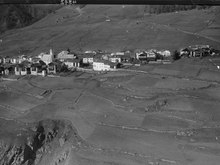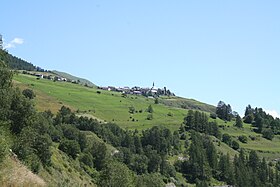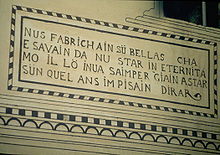Guarda GR
| GR is the abbreviation for the canton of Graubünden in Switzerland and is used to avoid confusion with other entries of the name Guarda . |
| Guarda | ||
|---|---|---|
| State : |
|
|
| Canton : |
|
|
| Region : | Engiadina Bassa / Val Müstair | |
| Political community : | Scuol | |
| Postal code : | 7545 | |
| former BFS no. : | 3742 | |
| Coordinates : | 807 145 / 184 073 | |
| Height : | 1653 m above sea level M. | |
| Area : | 31.42 km² | |
| Residents: | 161 (December 31, 2013) | |
| Population density : | 5 inhabitants per km² | |
| Website: | www.guarda.ch | |
|
Guarda GR |
||
| map | ||
|
|
||
Guarda ( ) is a village in the municipality of Scuol , which is in the Sur Tasna district in the Inn district of the Swiss canton of Graubünden . In Guarda, Romansh is spoken by the majority .
Until December 31, 2014 Guarda was an independent political municipality . On January 1, 2015 Guarda was merged with the four municipalities of Ardez , Ftan , Sent and Tarasp into the municipality of Scuol.
geography

Guarda consists of about seventy houses and is located on a sunny, rocky terrace on the north side of the Inn valley at an altitude of 1650 m . Due to its location and the intact townscape, the village is a good starting point for hikes in the area and a popular destination for tourists. Guarda train station is 40 minutes' walk below at 1431 m , right next to the Giarsun district .
history
The Patnal stone wall probably dates back to the Iron Age. Guarda was first mentioned in 1160 as Warda in a deed of donation from the nobles of Tarasp to the Chur bishop. The word means guard, control room or place to look out from. In the High Middle Ages it was a court settlement on the old Engadine road that connected Lake Como with Innsbruck. The church separated from the neighboring village of Ardez in 1494, when the Gothic church was probably built. The village was destroyed in 1499 during the Swabian War, only the church and a few houses survived the pillage. The Auasagna desert is mentioned as a medicinal spring in the 16th century. Together with the neighboring town of Lavin , Guarda converted to the Reformed faith in 1529, which was mainly due to the work of the reformer Philipp Gallicius . In 1622 Guarda was destroyed by Austrian conquerors around Colonel Alois Baldiron , but then rebuilt; and in 1652 it was ransomed by Habsburg Austria.
Until 1851 Guarda with its four factions Giarsun, Guarda Pitschen, Chaminadas and Auasagna belonged to the judicial community of Obtasna. The construction of the Talstrasse from 1862 to 1865 let the income from the framing dry up and the economic progress largely bypassed the village. In 1913 Guarda received a station on the Rhaetian Railway, which is located next to the hamlet of Giarsun. Tourism, as tourism was called back then, increased somewhat as a result. From 1939 to 1945 around 30 old houses were restored by the Bündner Heimatschutz . The local architect Iachen Ulrich Könz created the renovation concept and budget from 1937 to 1938. As one of the best preserved Engadine villages, Guarda received the Wakker Prize in 1975 and in 1985 was classified as a site of national importance.
Agriculture gave up arable farming in the middle of the 20th century and switched to livestock farming with milk and meat production. For this purpose, new stables were built on the edge of the village. Since 1987, mountain herbs have been grown. The primary school closed in 2005 due to too few children. The post office and the tourist office are open every day, which also applies to the VOLG village shop.
economy
Guarda lives mainly from mountain agriculture, crafts and tourism. In 1930 there were still 38 full farms in Guarda, in 1984 there were 18 and in 2015 there were still 10 farms. In addition to day tourism, three hotels and around 30 holiday apartments support gentle and sustainable tourism. Various smaller craft and service businesses revitalize the village and contribute to its survival.
population
Between 1850 and 1860, 1888 and 1920, and 1930 to 1980 there were three waves of emigration to the town. People migrated to the industrial centers and tourist spots in search of work and a better life. For this reason, the population fell by more than half (1850–1980: −52%) from 280 to 134 people (1900: 245 people; 1950: 193 people) in these 130 years. Since then, the population has increased again (1980–2005: +36%; 1990: 165 people; 2000: 144 people), but are well below the level of 1850.
languages
The Romansh idiom Vallader is still used by a majority of the population as an everyday language. Up until 1980 the population was almost entirely Romansh-speaking (1880 96%, 1900 99%, 1941 91% and 1980 90%). As a result of the language change of the locals and German-speaking immigrants, Romansh has lost ground compared to German, especially in the last twenty years - despite support from the community and school. In 1990 91% and in 2000 79% of the population reported a knowledge of Romansh. The following table shows the development over the past decades:
| Languages in Guarda | ||||||
| languages | 1980 census | 1990 census | 2000 census | |||
| number | proportion of | number | proportion of | number | proportion of | |
| German | 9 | 6.72% | 42 | 25.45% | 44 | 30.56% |
| Romansh | 121 | 90.30% | 119 | 72.12% | 90 | 62.50% |
| Residents | 134 | 100% | 165 | 100% | 144 | 100% |
Alongside Romansh and German, French was one of the three most frequently used languages in 2000 with a 2.78% share.
Religion and denominations
In 1529 the residents of the village, together with the neighboring village Lavin, converted to Protestant teaching under the influence of the reformer Philipp Gallicius , who was then living in Lavin.
Origin and nationality
Of the 182 residents at the end of 2005, 163 were Swiss nationals.
traffic
Guarda has its own train station, which is not in the center of the village, but below on Hauptstrasse 27 near the Giarsun fraction . The place is connected to the train station by a bus line and a steep footpath. The trains of the Rhaetian Railway stop in Guarda.
Guarda is also on the long-distance hiking trail of the Via Engiadina .
Culture and sights
Guarda is one of the best preserved Engadine villages and is therefore both architecturally and historically interesting. The village consists almost exclusively of the typical Engadine houses with numerous sgraffiti : Jecklin House, Könz House, Bart House.
The village received the Wakker Prize in 1975 for its exemplary maintenance of the townscape .
Guarda is the setting of the famous children's book Schellenursli , which was written by Selina Chönz and illustrated by Alois Carigiet . Selina Chönz's son, the painter Steivan Liun Könz , lived and worked in Guarda until his death.
The reformed church in the village center is worth seeing . In Giarsun there is a strange prehistoric stone wall.
In the tradition of the nicknames of the Engadine villages , the inhabitants are called Guardas ils speculants (German for "the speculators").
photos
Engadine house and wooden fountain
Personalities
- Iachen Ulrich Könz (1899–1980), architect
- Selina Chönz (1910–2000), writer
- Steivan Liun Könz (1940–1998), draftsman, illustrator and sgraffito artist
literature
- Erwin Poeschel : The art monuments of the canton of Graubünden III. The valley communities Räzünser Boden, Domleschg, Heinzenberg, Oberhalbstein, Upper and Lower Engadine. (= Art Monuments of Switzerland. Volume 11). Edited by the Society for Swiss Art History GSK. Bern 1940. DNB 760079625 .
- JU Könz : Guarda, a resurrecting Engadine village. In: Heimatschutz = Patrimoine. Journal of the Swiss Association for Homeland Security , Vol. 36, 1941, pp. 5–21 ( digitized version ).
- Nott Caviezel: Guarda (= Swiss Art Guide. No. 372/373: Ser. 38). 3rd corrected edition. Society for Swiss Art History, Bern 1993, ISBN 3-85782-372-0 .
- Simon Bundi: Graubünden and homeland security. From the invention of the homeland to the preservation of the village of Guarda (= sources and research on Bündner history. Vol. 26). Chur 2012, ISBN 978-3-85637-418-1
- Christian Spannagl and Florian Stürmer: Guarda - The most beautiful village in the Lower Engadine. 2014 and 2015
Web links
- Official website of the municipality of Guarda
- Photos from Guarda on Epics - Engadin picture page
- Paul Eugen Grimm: Guarda. In: Historical Lexicon of Switzerland .
- Guarda on the website of myswitzerland
Individual evidence
- ↑ a b Paul Eugen Grimm: Guarda. In: Historical Lexicon of Switzerland .
- ^ Christian Spannagl and Florian Stürmer: Guarda - The most beautiful village in the Lower Engadine. 2014 and 2015, pages 50-134
- ↑ Shops in Guarda at www.engadin.com ( Memento of the original from January 10, 2017 in the Internet Archive ) Info: The archive link has been inserted automatically and has not yet been checked. Please check the original and archive link according to the instructions and then remove this notice.
- ↑ Via Engiadina high-altitude hiking trail in the Lower Engadine at www.engadin.com
- ↑ Via Engiadina on map.wanderland.ch
- ↑ Jecklin House
- ^ Residence in Könz
- ↑ Bart's house
- ↑ Prehistoric stone wall










